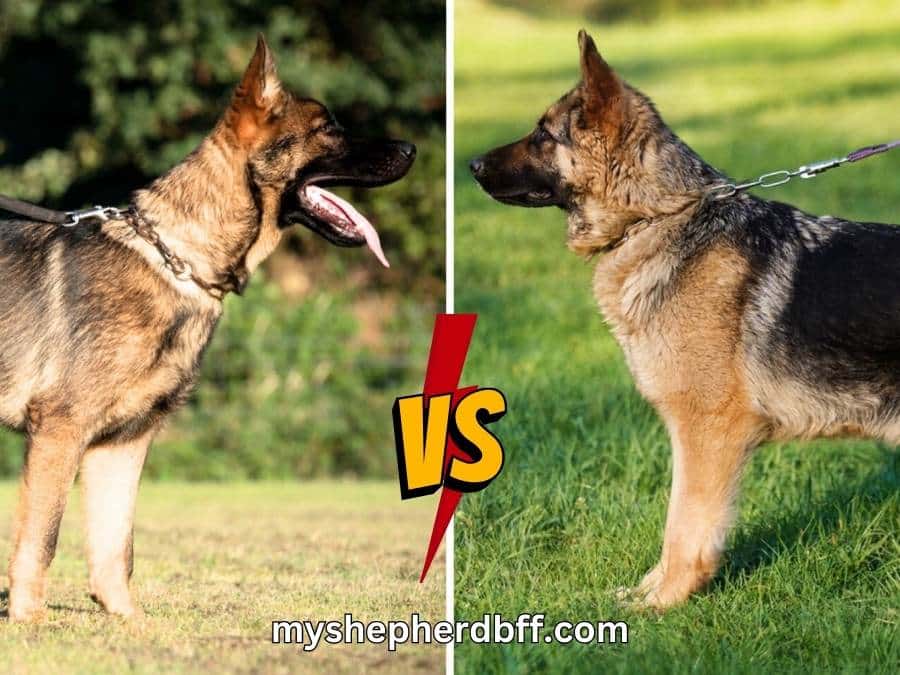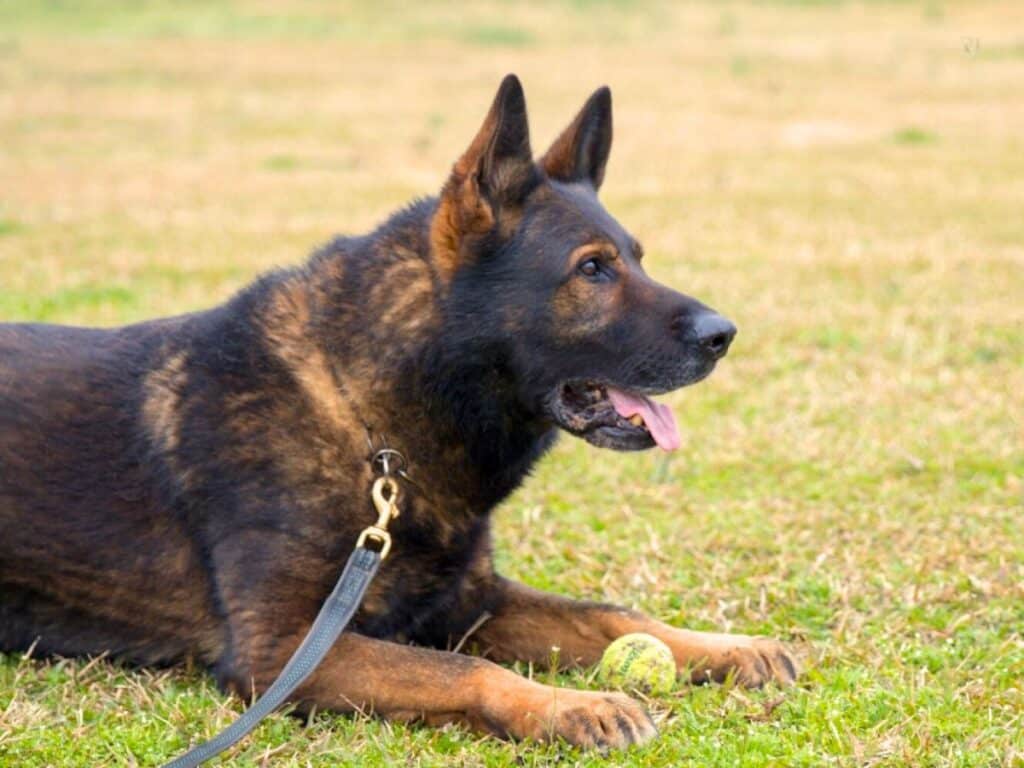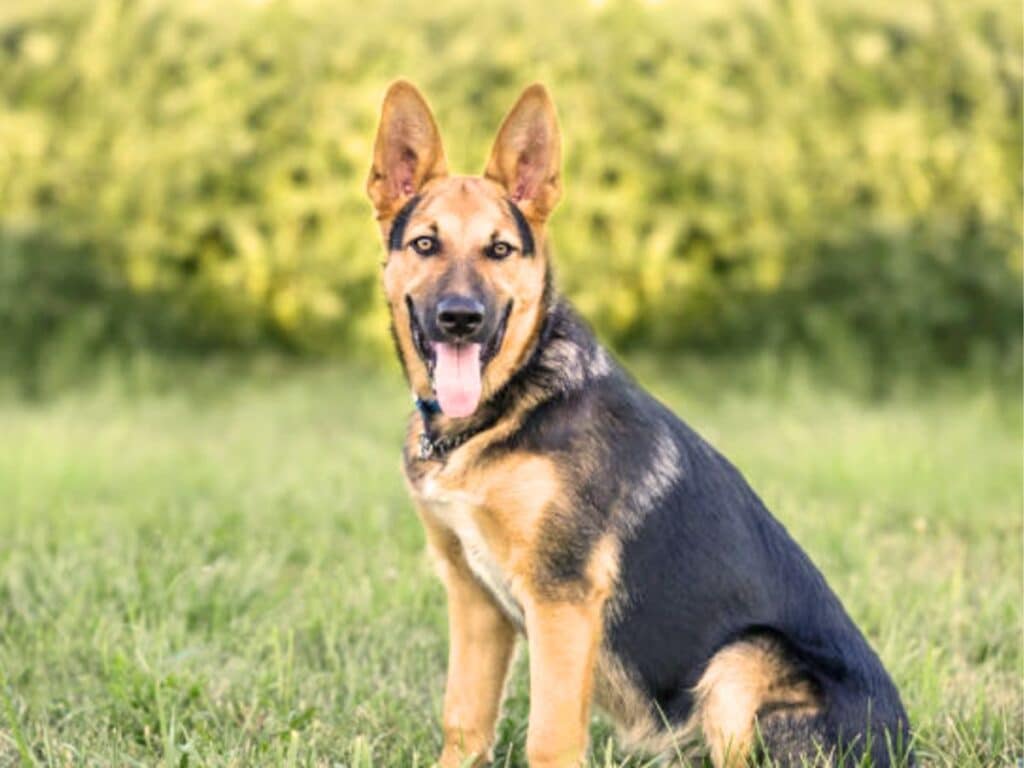So what’s the difference between a working line and a show line German Shepherd?
Well, in simple terms, working line German Shepherds are like action heroes – they’re smart, strong, agile, and great at tasks like military and police work. They’re built for function, not just looks.
Show line German Shepherds, on the other hand, are like supermodels – bred to look good in dog shows, focusing more on appearance than specific skills.
Both come from the same family, but working dogs are all about the job, while show dogs are more about looking pretty.
Let’s find out more!
Working Line vs Show Line German Shepherds
Working line German Shepherds typically have a leaner and more athletic build, with a focus on functional strength and endurance. They often have a straighter back and hindquarters, and a shorter coat.
Working line GSDs are bred for their intelligence, agility, and strong work ethic, making them ideal for tasks like military and police work.
Show line German Shepherds, on the other hand, may have more angulated hindquarters, a sloping back, and a longer coat. These dogs are bred with an emphasis on conforming to the breed standard, prioritizing appearance and movement in conformation events.
Here’s a table highlighting the main differences between Working Line and Show Line GSDs:
| Working Line GSD | Show Line GSD | |
| Appearance | – Strong and athletic build- Less emphasis on physical beauty | – Elegant and graceful build- Emphasis on physical beauty |
| Average Height (adult) | 22–26 inches | 22–26 inches |
| Average Weight (adult) | 50-90 pounds | 50-90 pounds |
| Temperament | – High energy and drive – More suitable for active and working roles – More focused | – Calmer and more relaxed – More suitable for show and companionship roles – Laid back |
| Health | – Generally healthier with fewer genetic issues | – More prone to genetic issues due to selective breeding for appearance |
| Coat Type | – Shorter and denser double coat with a straighter, harsher texture – Better protection against weather and harsh conditions | – Longer and fluffier double coat, with a more luxurious appearance |
| Coat Color | Varied, including bi-color, sable, and solid black | Predominantly bi-color, often with a black and red/tan |
| Purpose & Training | – Bred for working roles such as police or search and rescue – Require more mental and physical stimulation – Excel in tasks that require intelligence and athleticism | – Bred for show and obedience competitions – Require less mental and physical stimulation – Excel in tasks that require obedience and conformation |
| Cost | $800 – $2500 | $800 – $5000 |
When did the breeding of German Shepherd Lines begin?
The breeding of different lines of German GSDs began in the early 20th century.
Max von Stephanitz, a German breeder and former cavalry officer, is often credited as the father of the German Shepherd breed.
In 1899, he discovered a remarkable working dog named Hektor Linksrhein (also known as Horand von Grafrath) and recognized its potential to become an exceptional breed.

Impressed by Hektor’s intelligence, loyalty, and physical attributes, Stephanitz founded the Verein für Deutsche Schäferhunde (Society for the German Shepherd Dog) with the aim of creating a standardized breed.
The Split into Working Line and Show Line
As German Shepherds gained popularity worldwide, different breeders began to focus on specific traits they deemed important. This led to a split within the breed into two distinct lines: working line and show line.
- Working Line: Breeders who prioritized maintaining the original working abilities of German Shepherds continued to produce dogs with strong drives for herding or protection work.
- Show Line: On the other hand, some breeders started emphasizing appearance over function. They aimed to create dogs that conformed closely to the breed standard established by Max von Stephanitz but may have sacrificed certain working capabilities in favor of aesthetics.
Characteristics of Working Line German Shepherds
1. High Energy Levels and Active Lifestyles
Working line dogs are known for their high energy levels, which make them perfect companions for individuals with active lifestyles or demanding jobs.

These dogs thrive in environments where they can channel their energy into physical activities and mental stimulation. Whether it’s going on long hikes, participating in agility courses, or engaging in intense training sessions, working line Shepherds are always up for the challenge.
Their natural athleticism and stamina allow them to excel in various tasks such as search and rescue missions, police work, herding livestock, and even competitive sports like obedience trials.
These dogs require regular exercise to keep both their bodies and minds engaged. Without adequate physical activity, they may become bored or develop behavioral issues due to pent-up energy.
2. Strong Drive to Work, Learn, and Please Their Handlers
One of the defining characteristics of working line dogs is their unwavering drive to work, learn new skills, and please their handlers. They possess an innate desire to be productive and enjoy having a job to do. This strong work ethic makes them highly trainable and willing to take on challenging tasks.
These dogs thrive when given a sense of purpose and direction. They eagerly respond to commands and are quick learners who excel in obedience training. Their intelligence allows them to understand complex instructions while remaining focused on the task at hand.
3. Intense Prey Drive Compared to Show Lines
Working line Shepherds often exhibit a more intense prey drive as compared to show lines. Prey drive refers to a dog’s instinctual motivation to chase after moving objects or animals. In working lines, this trait is heightened due to their breeding history that prioritizes traits necessary for specific working tasks.
Their intense prey drive makes them well-suited for jobs such as search and rescue, where they need to track scents and locate missing individuals. It also contributes to their exceptional ability in apprehending suspects during police work.
However, it’s important to note that this heightened prey drive requires appropriate training and management to ensure it is channeled appropriately.
These dogs may not be suitable for households with small pets or animals due to their strong instinctual urge to chase.
RELATED: How To Buy a German Shepherd Puppy
Types of Working Line German Shepherd
1. DDR German Shepherd
The DDR German Shepherd is a type of working line German Shepherd that originated in the former East Germany. These dogs were bred for their exceptional working abilities and were primarily used as police, military, and search and rescue dogs.
The acronym “DDR” stands for Deutsche Demokratische Republik, which was the official name of East Germany.
RELATED: Role & History of German Shepherd Military Dogs

2. Czech German Shepherd
The Czech German Shepherd is another type of working line German Shepherd that hails from the Czech Republic. Like DDR German Shepherds, these dogs were bred with a specific focus on working abilities rather than conforming to breed standards for dog shows.
3. West German Shepherd
The West German Shepherd is a type of working line German Shepherd that originated in West Germany. This line of German Shepherds was developed with an emphasis on maintaining the breed’s versatility, intelligence, and working abilities.
West German Shepherds are known for their impeccable temperament and stable character. They possess a calm and confident demeanor that allows them to handle stressful situations with ease. This trait makes them well-suited for various roles such as therapy dogs, service dogs, or even as family companions.
Here are a few related articles that you may find useful
- 5 Types of German Shepherds: Which is Right For You?
- Working Line & Show Line German Shepherd Growth Chart
- Working Line & Show Line German Shepherd Feeding Guidelines
- Common Health Problems In Working Line & Show Line German Shepherds
- Working Line & Show Line German Shepherd Life Expectancy
Characteristics of Show Line German Shepherds
Show line German Shepherds are a distinct type within the breed, focusing on physical appearance and conforming to the standards set by kennel clubs and breed organizations.
1. Emphasis on Conforming to Breed Standards
These dogs are bred with the intention of showcasing the ideal physical attributes outlined by kennel clubs. Breeders carefully select breeding pairs that possess desirable traits such as correct angulation, proportionate body structure, and well-defined markings.
The goal is to produce puppies that closely resemble the breed standard, ensuring uniformity in appearance within the show ring.
To achieve this level of conformity, show line German Shepherds undergo rigorous evaluations at dog shows where judges assess their adherence to breed standards.
Attention is given to various aspects including head shape, ear placement, coat quality, and overall physique. Dogs that exhibit deviations from these standards may be penalized or disqualified from competition.
RELATED: How Much is a German Shepherd?

2. Calmer & Laid Back Temperament
Their calm demeanor often makes them more compatible with a variety of households, including families with children, elderly individuals, or individuals who prefer a less energetic dog. Their stable temperament allows them to adapt well to different family dynamics and lifestyles.
3. Gentle with Children
Show Line GSDs with a calmer temperament are generally more patient and gentle with children. They tend to have a higher tolerance for the enthusiastic play and occasional mishandling that can occur when children interact with dogs.
This can help create a safer and more harmonious environment for both the dog and the children.
4. Suited for Obedience Trials and Dog Shows
Show line German Shepherds excel in activities that require precision, obedience, and the ability to perform complex tasks. Their calm temperament and willingness to please make them ideal candidates for obedience trials. These competitions test a dog’s ability to follow commands accurately and execute various exercises with precision.
Types of Show Line German Shepherds
1. American Show Line German Shepherd
The American Show Line German Shepherd is a distinctive breed that has been specifically bred for its appearance and show qualities. These dogs are known for their elegant and graceful movement, as well as their striking physical features.
With a focus on conformation and beauty, the American Show Line German Shepherds have become popular in the world of dog shows.
One of the key characteristics of the American Show Line German Shepherd is their impressive stance. These dogs have a strong and proud posture, with an arched neck and a deep chest. Their hindquarters are well-muscled, allowing them to move with grace and agility.
2. European Show Line German Shepherd
Unlike their American counterparts, European show line dogs have been primarily bred for their working abilities rather than appearance alone. While they still possess remarkable physical attributes, such as a strong build and an alert expression, their working capabilities take precedence.
The European show line German Shepherds often have a more robust build compared to the American Show Line. Their bodies are muscular and well-proportioned, allowing them to perform physically demanding tasks with ease. The head is typically broader with a pronounced stop between the forehead and muzzle.
Physical Differences Between Working Lines and Show Lines

1. Athletic Build and Muscle Definition
Working lines of German Shepherds are known for their more athletic build and greater muscle definition. These dogs are bred specifically for their working abilities, such as police work or search and rescue. As a result, they have a leaner and more muscular physique compared to show lines.
In contrast, show lines often prioritize appearance over working abilities. While they may still be well-built dogs, their muscle definition is typically less pronounced than that of working line dogs.
2. Rear End Angulation and Backline Slope
One noticeable difference between working lines and show lines is the angulation of the rear end and the slope of the backline. Show line German Shepherds tend to have a more angulated rear end, meaning that the angle between their hind legs and pelvis is more pronounced. This angulation contributes to their characteristic gait in the show ring.
On the other hand, working line German Shepherds generally have a less pronounced rear end angulation. Their hind legs align more closely with their pelvis, allowing for efficient movement during physically demanding tasks.
Working lines often exhibit a straighter backline compared to the sloping backline commonly seen in show lines.
RELATED: Straight Back German Shepherd vs Sloped Back GSD
3. Coat Length Variations
Both types can have either short or long coats; however, there tends to be more diversity in coat length within the working line population.
Working line German Shepherds may have shorter coats that provide better protection against environmental elements during outdoor work. On the other hand, some individuals within this group may possess longer coats which can still serve them well in certain climates or conditions.
Show line German Shepherds predominantly showcase longer coats, as this is often favored in the show ring for its aesthetic appeal. The longer coat enhances their overall appearance and can contribute to a more majestic presence during competitions.
4. Color Variations
Working Line German Shepherds:
- Sable: Working line Shepherds often display a wider range of sable coloration, including dark sable, light sable, and various shades in between. Sable dogs have a coat color that ranges from light to dark with black-tipped hairs.
- Bi-color and Black: Working lines commonly have solid black or bi-color coats, which typically consist of a solid black body with tan markings on specific areas like the legs and face.
- Solid Colors: Some working line dogs can be solid black or solid liver (brown).
Show Line German Shepherds:
- Black and Red: Show line Shepherds commonly exhibit the black and red coloration, where the main body color is black with rich tan/red markings on the legs, face, and other areas.
- Bi-color and Black: Show lines may also have bi-color coats, similar to working line German Shepherds. The bi-color pattern includes a solid black body with tan markings.
- Solid Colors: While less common, show line dogs can also come in solid black or solid liver colors.
It’s important to note that these observations are not strict rules and variations can exist within each line.
RELATED: German Shepherd Colors: All 14 Shades Explained In Detail
Temperament and Behavior: Working Line vs Show Line GSDs

Different Breeding Goals, Different Temperaments
Working lines are bred for their drive, intensity, and work ethic, making them ideal for tasks like herding, search and rescue, or police work.
On the other hand, show lines are bred with an emphasis on conforming to breed standards and excelling in dog shows. As a result, they tend to have calmer temperaments while still maintaining confidence.
The Driven Nature of Working Line GSDs
One of the defining characteristics of working line GSDs is their high drive level. These dogs possess an incredible amount of energy and enthusiasm that needs to be channeled appropriately.
Without sufficient mental and physical stimulation, working line GSDs can easily become bored and develop behavioral issues such as excessive barking or destructive chewing.
The Adaptability of Show Line GSDs
While working line GSDs are known for their drive and intensity, show line GSDs tend to exhibit a more adaptable nature. This adaptability makes them better suited for various living environments such as apartments or homes with smaller yards.
Show lines are often more content with moderate exercise routines compared to the higher demands of working lines.
Show line GSDs generally possess a calmer demeanor without compromising on confidence or intelligence. They can be more relaxed and easygoing, making them suitable for families or individuals who prefer a companion that is not overly energetic or demanding.
Check out this video that explains the difference between working line and show line German Shepherds…
Pros and Cons of Show Line German Shepherds
Pros
1. Ideal for families looking for a versatile companion
Show line dogs are an excellent choice for families seeking a loyal and adaptable furry friend. These dogs make wonderful companions in various activities such as obedience or agility trials. Their versatility allows them to excel in different dog sports, making them perfect for families who enjoy participating in these types of events.

2. Aesthetically appealing dogs
One of the significant advantages of show line German Shepherds is their impressive appearance. With their well-defined structure, beautiful coats, and regal presence, these dogs are often considered the epitome of elegance. Their majestic looks can be a source of pride for owners who appreciate having a visually striking pet by their side.
3. Adaptable & Intelligent
In addition to their aesthetic appeal, show line dogs are known for their adaptability and trainability. They have the intelligence and willingness to learn that makes them suitable candidates for obedience trials. Whether it’s mastering commands or performing complex routines, these dogs thrive on mental stimulation and enjoy showcasing their skills in front of an audience.
Cons
1. May have less drive or intensity
One potential downside is that they may have less drive or intensity compared to working lines. Working line dogs are bred specifically for tasks like herding or protection work, which requires a high level of energy and focus.
In contrast, show line dogs have been selectively bred for their appearance, leading to a potential decrease in their drive to perform demanding tasks.
2. Prone to health issues
Another concern with show line German Shepherds is the potential health issues associated with breeding emphasis on appearance. Over time, breeders have focused on specific physical traits desired in the show ring, such as angulation or slope of the back.
Unfortunately, this selective breeding can lead to an increased risk of certain health problems (Study).
Show line German Shepherds may be more prone to hip dysplasia, elbow dysplasia, or other joint-related issues due to these breeding practices.
Pros and Cons of Working Line German Shepherds
Pros
1. Strong work drive
One of the biggest advantages of working line German Shepherds is their unparalleled work ethic. These dogs have an innate drive to perform tasks and are highly motivated to please their handlers.
Their strong work ethic combined with their intelligence allows them to quickly learn new commands and adapt to various situations. This makes them ideal for active individuals or professionals who require a reliable working partner.
2. Exceptional physical capabilities
Another advantage is the physical prowess of these dogs. They are bred for athleticism and stamina, enabling them to handle physically demanding tasks with ease.

Whether it’s running long distances, jumping over obstacles, or engaging in bite work during protection training, working line German Shepherds possess the strength and agility needed to excel in these activities.
3. Loyalty and Protective Instincts
Working line dogs have a strong sense of loyalty and protective instincts towards their handlers and families. They are naturally inclined to guard and protect, making them excellent personal and property protection dogs.
4. Stable temperament
Working line German Shepherds are typically bred for stable temperaments, allowing them to remain calm and focused in stressful situations. They have the mental resilience required for challenging tasks and can handle pressure and high-stress environments.
Cons
1. High energy levels & exercise needs
These dogs have an abundance of energy that needs to be properly channeled through regular exercise and mental stimulation. Without sufficient outlets for their energy, they may become bored or frustrated, which can lead to behavioral issues such as excessive barking or destructive chewing.
2. Strong Prey Drive
Many working line German Shepherds have a strong prey drive, which can make them prone to chasing smaller animals or exhibiting predatory behavior. It’s important to manage their prey drive through training and socialization to prevent any harm to other animals or potential conflicts in public spaces.
3. Independence and Strong-Willed Nature
Working line German Shepherds can be independent and have a strong-willed nature. While this trait is often advantageous in working roles, it can be challenging for some owners who prefer a more compliant and easygoing companion. Consistent and firm training techniques are necessary to establish boundaries and ensure a harmonious relationship.
Which German Shepherd Line is Right for You?

There are several factors to consider. Here are a few questions that you should ask yourself before determining which bloodline is right for you.
1. What’s your lifestyle and activity level?
If you lead an active lifestyle and enjoy outdoor activities such as hiking or running, a working line German Shepherd may be the better choice. These dogs are bred for their athleticism and high energy levels. Working line Shepherds thrive on mental stimulation and physical challenges. They require regular exercise to prevent boredom and destructive behaviors.
On the other hand, if you prefer a more laid-back companion who will happily curl up on the couch with you after a long day, a show line German Shepherd may be more suitable. Show line Shepherds have been bred primarily for their conformation to breed standards rather than working ability. While they still possess intelligence and loyalty, they tend to have lower energy levels compared to their working line counterparts.
2. Do you have prior experience of owning dogs?
Your experience with dogs also plays a crucial role in determining which bloodline is right for you. Working line Shepherds can be more challenging to handle due to their intense drive and need for mental stimulation.
They require experienced owners who can provide consistent training and guidance. Show line Shepherds are generally easier to handle but still benefit from basic obedience training.
3. Why do you want a German Shepherd?
Consider your specific goals when choosing between these bloodlines. If you’re interested in competitive dog sports or want a versatile working partner, a working line German Shepherd may be ideal.
However, if your main goal is simply having a loyal family pet who excels at being by your side without requiring intense training or competition involvement, a show line German Shepherd could be the perfect fit.
Conclusion
The debate between working line vs show line German Shepherds showcases the distinct qualities and purposes of these two variations within the breed. While both types share common ancestry and possess admirable traits, they have been selectively bred for different functions, resulting in notable differences in appearance, temperament, and working abilities.
The choice between the two should depend on an individual’s specific needs and lifestyle. If an active and highly involved working partnership is desired, a working line dog is likely the better fit.
Frequently Asked Questions (FAQs)
1. Can I have a working line German Shepherd as a family pet?
Yes, working line German Shepherds can make great family pets if they receive proper training, socialization, and exercise. However, their high energy levels and intense drive may require more dedication and experience from the owner.
2. Are show line German Shepherds suitable for protection work?
While show line German Shepherds are not typically bred for protection work like their working line counterparts, individual dogs within the show lines can still possess protective instincts. However, it is essential to evaluate each dog’s temperament and training suitability before considering them for protection tasks.
3. Which bloodline is better for competitive obedience trials?
Working line German Shepherds are often favored in competitive obedience trials due to their high trainability, focus, and drive. Their natural abilities make them well-suited for excelling in obedience exercises.
4. Do both working lines and show lines require extensive grooming?
Both working lines and show lines of German Shepherds have double coats that shed moderately throughout the year. Regular brushing is necessary to maintain coat health and manage shedding. However, show lines may require more meticulous grooming to keep their longer fur looking its best.
5. Can I find mixed-breed German Shepherds with traits from both bloodlines?
It is possible to find mixed-breed German Shepherds that exhibit characteristics from both working lines and show lines. These dogs are often referred to as “working/show mix” or “show/working mix.”




